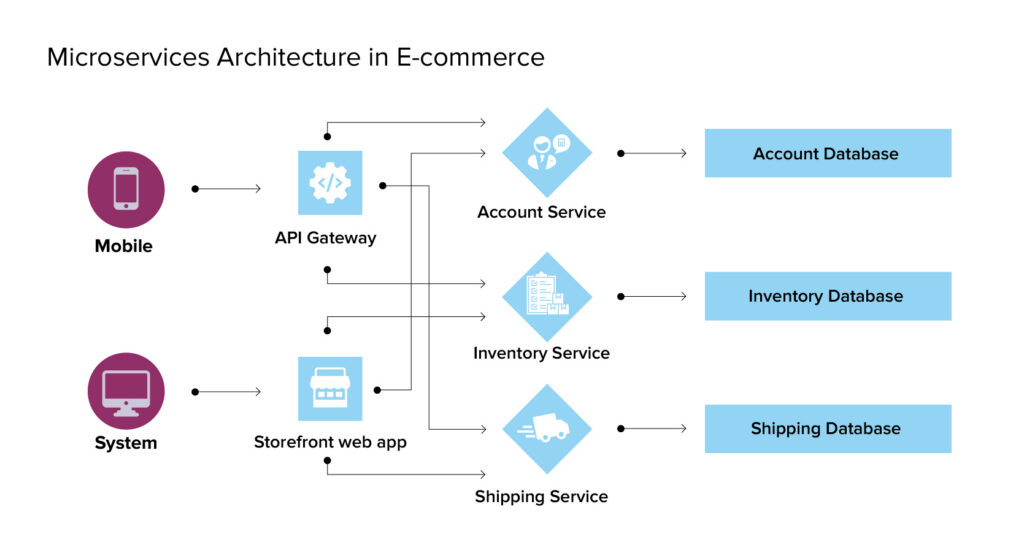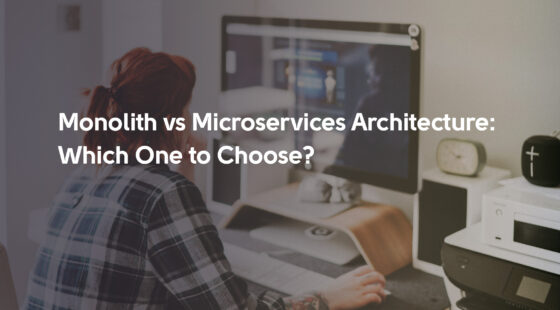When e-commerce first started, most online stores were constructed as monolithic apps. Everything from the catalog and cart to payments and shipping resided in one codebase and was shipped together. That configuration held early on, but the fissures began to appear when platforms scaled: each new payment option or promo required the whole app to be redeployed, and a bug on the cart would bring the entire store down. Enter microservices: an architecture that divides your commerce stack into small, autonomous services. Each service possesses an individual capability and communicates through well-defined APIs such that teams can individually build, deploy, and scale components.
It's where the market is going, too. Inspired by the requirements for scalability, agility, and fewer shutdowns, companies of all sizes are embracing e-commerce microservices. Already, about 85% of businesses indicate usage of commerce microservices. By shifting from inflexible, everything-all-at-once platforms, stores can keep up with shifting customer behavior, increasing demands, and the demand for a hassle-free omnichannel experience in web, mobile, and in-store.
In this article, we explore an e-commerce microservices architecture example, highlight the major advantages of the approach, explore the businesses that have already implemented it, and demonstrate how it facilitates great omnichannel shopping.
Highlights:
- Around 85% of e-commerce enterprises use microservices, while mid-market adoption is ~75–84%.
- Fault isolation keeps the store online even when one service fails.
- Modular design simplifies integrations and step-by-step legacy modernization.
What is an E-commerce Microservices Architecture?
At its core, an e-commerce microservices architecture is a set of loosely coupled services that work together to support the customer journey. Instead of a single, monolithic codebase, you have many small applications, often referred to as microservices, each responsible for a specific task: user authentication, product catalog, search, shopping cart, pricing, payments, orders, inventory, and notifications, among others.
Picture how a typical request moves through the stack. The web or mobile app calls the gateway. The gateway sends the call to the service that can help. Authentication confirms the user. Catalog returns product details, and the search service queries the index. The cart tracks selections, the pricing service applies discounts or promotions, and payments confirm the charge. Order management initiates fulfillment, reserves inventory stock, and sends notifications with the receipt. Because each step runs in its own service and the services interact through clear contracts, teams deploy updates more often, isolate faults faster, and keep the store responsive. Larger platforms add recommendations, reviews, personalization, tax, and external integrations, but the core principle stays the same: keep each service focused and avoid shared databases. See its work principles on the e-commerce microservices architecture diagram below.

Components of an E-commerce Architecture Based on Microservices
Assume that you're developing an e-commerce application to showcase the details of the products, track the inventory levels, collect orders from the customers, and maintain a blog to publish e-commerce topics.
The architecture consists of a user interface (web application and mobile app), routing layer (API gateway, load balancer, service registry, and message broker), several services that provide e-commerce-specific functionality, and storage and retrieval databases. Additionally, there is a third-party content management API used to manage the blog. In the following sections, discover the role played by each component of this architecture.
User interface
The user interface provides a way for end users (e.g., customers, inventory managers, or external partners) to interact with the system and carry out specific operations (e.g., search for an item, add an item to the shopping cart, or add an item to the inventory).
For e-commerce systems, it is typical to provide a Graphical User Interface (GUI) that is usable on both desktop and mobile devices. You can build these UIs using client-side web development frameworks such as React, Angular, or Vue.js.
Routing layer
As users conduct activities through the user interface, the UI makes requests to the routing layer. The routing layer then forwards requests it receives from the UI (or from another microservice) to one or multiple target microservices. A standard routing layer consists of an API gateway, load balancer, service registry, and message broker.
Since each microservice in the e-commerce system provides its own API and there are typically multiple microservices, the web and mobile UIs may need to send multiple requests to different microservices to retrieve inventory and product information. The API gateway reduces the need to make multiple requests to different microservices by serving as a single entry point for requests. It may simply forward requests to the appropriate microservice or fan out a single request to multiple services. It also serves as a layer of indirection that enables you to make changes to the structure or functionality boundaries of your microservices with minimal impact on the functionality of the UI.
Microservices
Each microservice runs a separate part of functionality within the e-commerce system. A few examples include the Inventory service that handles the availability of products; the Shopping Cart service that maintains each user’s shopping cart separately; the Checkout service that processes the orders based on products contained within the shopping cart; and the Blog service that handles content for the blog posts.
Databases
Lastly, an e-commerce system must store and retrieve data on products, shipments, purchases, and other details required to run an online store. Data used to perform e-commerce functions is normally kept in one or multiple databases. Handling diverse types of data may require a single specialized database or multiple database types.
10 Reasons to Consider Microservices for Your Online Store
Microservices promise faster innovation and greater resilience, but they also introduce complexity. Below are 10 compelling reasons, drawn from industry sources and real‑world experiences, to adopt microservices for e-commerce.
Reason #1. Elastic scaling of specific components
Traffic to the web store is quite varied. A social media explosion or holiday promotion may result in a rush of search and purchase activity. Monolithic architecture forces you to scale the entire application when experiencing growth in a particular region. Microservices enable you to scale the services that need the increased capacity. You can add resources to the search or checkout service when demand is greatest without having to scale the entire system. Cloud‑based microservices architectures enable retailers to scale up or down based on real‑time traffic. This targeted scaling keeps your site responsive and cost‑efficient.
Reason #2. Freedom to choose the right technology stack
Because each microservice is independent, developers can select the tools and programming languages best suited for the task. Their architecture makes it possible to layer services gradually, replacing or upgrading one component at a time. This flexibility encourages experimentation and ensures your platform stays current with evolving technology.
Reason #3. Faster feature delivery and experimentation
In a competitive market, retailers must quickly roll out new features: loyalty programs, new payment options, or personalized recommendations to attract and retain customers. In a monolith, even small changes require coordinating across the entire codebase and waiting for scheduled releases.
Microservices eliminate the bottleneck. Each team owns the service, deploys patches on its own schedule and delivers features when it is finished. Microservices favor rapid deployment, enabling the teams to deploy new functionality into production right away as soon as it passes testing. Since services are decoupled, teams may even perform A/B tests on isolated features, collect real-time feedback, and iterate rapidly without risky worldwide releases.
Reason #4. Improved fault isolation and resilience
With a monolithic application, failure in a single module, forces everything down. Microservices insulate failures. If the inventory service crashes, the catalog, and search continue to operate; customers keep browsing while you repair the compromised part. The individual microservice may do its own authentication and authorization, individually controlling the breach or bug's blast. This architecture makes the overall platform more resilient and degrades gracefully when subjected to stress. By insulating failures, it is possible to design fallback behavior, for instance, if the recommendations service crashes, the storefront may continue serving default product pages.
Reason #5. Easier integration with third‑party systems
E-commerce uses external services to handle payments, shipping calculations, tax calculations, data analytics, etc. In a monolithic code base, it might take extensive changes across the application to add a new provider. Microservices encapsulate the integration. Each external API is encapsulated in its own service, offering an invariant internal interface.
Microservices simplify integration and allow the retailer to swap providers without breaking other aspects of the system. When implementing an extra shipping carrier or payment gateway, the corresponding microservice can be swapped or modified without affecting the cart, search, or catalog.
Reason #6. Enhanced security and compliance
Retailers handle sensitive data ranging from personal data to cardholder information and must adhere to regulations like GDPR and PCI DSS. Microservices apply enhanced security through the least privilege principle. Each service works with its data and controls access through appropriate APIs. It is possible to apply tight security controls to the payment service without having the same amount of overhead on the search service. Microservices make it easier to protect individual authentication and authorization policies and protect individual authentication and authorization policies and encrypt sensitive data. Compartmentalization minimizes the attack surface and makes it easy to comply with regulations.
Reason #7. Localization and customization by region
Selling globally means supporting multiple languages, currencies, and regional payment methods. In a monolithic platform, adding localization features often requires widespread changes. Microservices let you tailor specific services for different markets. For example, creating region‑specific payment and shipping services to accommodate local gateways and address formats. This flexibility helps you reach new markets without rewriting your entire platform. You might offer region‑specific taxes, shipping options, or local carriers through their own services, ensuring regulatory compliance while preserving a consistent core experience.
Reason #8. Gradual modernization of legacy systems
Many retailers run legacy monoliths that are difficult to replace in one step. Microservices offer a path to modernization without a risky “big bang” migration. You can incrementally extract functionality from the monolith and rebuild it as independent services. Microservices architectures allow new services to be layered into an existing platform, gradually replacing older components. This stepwise approach reduces risk and downtime. It also enables you to reuse parts of your legacy system while modernizing others, avoiding a costly rebuild.
Reason #9. Optimized cost and resource utilization
Traditional monoliths typically require overprovisioning to handle spike loads. As microservices enable scaling individual components, resources may be deployed where demand is the heaviest and instances shut down when demand is low. Microservices enable “scale up or down the services” on demand. This responsiveness translates into effective infrastructure usage as well as minimized cost of operation.
Reason #10. Alignment of teams with business capabilities
Microservices encourage organizational alignment. Instead of one large team working on a monolithic codebase, teams own individual services that map to business capabilities: search, catalog, promotions, checkout, etc. Breaking a system into small services allows teams to “work in parallel, be more productive and maintain a clear understanding of their responsibilities”. Each team can choose its own tools and release schedule. This autonomy fosters accountability and speeds up development.
E-Commerce Businesses That Adopted Microservices
Some of the world’s largest e‑commerce companies transitioned from monoliths to microservices to scale and innovate.
Amazon’s experience illustrates how breaking a sprawling monolith into discrete services can unlock agility. Facing delays and inflexibility, the company reorganized its platform around microservices, assigning small teams to own and operate individual components like search, checkout, and recommendations. This restructuring removed development bottlenecks, allowed critical functions to scale independently, and made it easier to isolate faults. Today, the e‑commerce giant relies on thousands of specialized services to deliver fast, reliable experiences worldwide. Read our recent article to know how to create a marketplace like Amazon.
Zalando, the European fashion leader, embraced a similar shift to support rapid growth. Adopting a “radical agility” mindset, the retailer empowered autonomous teams to build and run their own services. Engineers were free to choose the tools that best fit each domain, decoupling payments, the product catalog, and logistics. By reducing interdependencies, Zalando accelerated its development cycle, delivering new features quickly while maintaining platform stability and improving the customer experience.
For Etsy, the move to microservices was triggered by the need to reduce risk and release faster. When the application was monolithic, deployment had the potential to jeopardize the entire marketplace. By decomposing the application into services that run independently, the rules were changed: teams now manage end‑to‑end functionality, deploy small increments often and revert the change readily if required. Greater isolation and monitoring made it possible to have the platform both resilient and less complicated to modify, an acceptable trade-off to support the vision of millions of sellers.
Conclusion
Retail success hinges on smooth, reliable experiences and the ability to adapt fast. A microservices architecture gives your e-commerce platform that flexibility. By splitting the stack into independent services, you can scale only what’s under pressure, try new technologies without a full rebuild, and ship features continuously. You’ll also gain stronger fault isolation, tighter security, easier localization, and a safe path to modernize legacy systems, while aligning teams around clear business capabilities.
Leaders such as Amazon, Zalando, and Etsy demonstrate the possible scale. Nevertheless, microservices are never a one-size-fits-all solution; they bring operational sophistication and uncompromised DevOps. Your decision will largely depend on the maturity level of the product, the capacity of the team, and the long-term plan. If it decides to invest, the company will be purchasing flexibility: quicker response to customer demands, easier partner integrations, and the scale to expand around the globe.
Contact the Svitla Systems team for a microservices readiness review and migration roadmap tailored to your store. We’ll assess your current platform, outline a phased approach, and help you modernize with minimal risk.



![[Blog cover] E-commerce security best practices](https://svitla.com/wp-content/uploads/2025/04/Blog-cover-E-commerce-security-best-practices-560x310.jpg)
![[Blog cover] how to make a website like amazon](https://svitla.com/wp-content/uploads/2025/02/Blog-cover-how-to-make-a-website-like-amazon-560x310.jpg)
